 “Nudge” is somewhat of a naughtly word in English humour, forever associated with Eric Idle’s Nudge Nudge Wink Wink sketch. However in behavioural economics it has a very serious meaning as desribed last night on a BBC News item. It seems that when Job Centres recommend an applicant ot attend a Job Interview, the percent of people actualy turning up for interviews varies with how the letter is written. Small changes can “nudge” the applicant towards changing their behaviour and attendinmg.
“Nudge” is somewhat of a naughtly word in English humour, forever associated with Eric Idle’s Nudge Nudge Wink Wink sketch. However in behavioural economics it has a very serious meaning as desribed last night on a BBC News item. It seems that when Job Centres recommend an applicant ot attend a Job Interview, the percent of people actualy turning up for interviews varies with how the letter is written. Small changes can “nudge” the applicant towards changing their behaviour and attendinmg.
Tag Archives: Management Infotainment
Streaming brings UK Singles charts ever closer to Big Data and Business Intelligence.
 A new era in the rock and pop singles charts starts on July 6 which is a further development in digital data collection and reporting methods. Streaming will henceforth be included in chart positions in the following way. For every one hundred streams this will count as one sale in the chart assembly process. The logic for this ratio is that internet music streaming services such as Sweden’s Spotify, XBox Music and Deezer, provide music for the consumer which infers popularity but does not require a commitment to purchase. Streaming is either free to the user (who chooses specific tracks but with some adverts) or comes with a subscription payment and no adverts. On some measures streaming is approaching half of the singles market so it cannot be ignored. Artists such as Rihanna, Bastille and Arctic Monkeys (my favourite current band along with Kasabian) have huge streaming figures, approaching a hundred million.
A new era in the rock and pop singles charts starts on July 6 which is a further development in digital data collection and reporting methods. Streaming will henceforth be included in chart positions in the following way. For every one hundred streams this will count as one sale in the chart assembly process. The logic for this ratio is that internet music streaming services such as Sweden’s Spotify, XBox Music and Deezer, provide music for the consumer which infers popularity but does not require a commitment to purchase. Streaming is either free to the user (who chooses specific tracks but with some adverts) or comes with a subscription payment and no adverts. On some measures streaming is approaching half of the singles market so it cannot be ignored. Artists such as Rihanna, Bastille and Arctic Monkeys (my favourite current band along with Kasabian) have huge streaming figures, approaching a hundred million.
There are many ways in which the Charts can inform businesses and organisations in the field of Business Intelligence report best practice. The best BI enables decisions and actions to be taken in a business; is this the case with the Charts? Certainly! The music industry is a business, and if an unknown artist gets their first record in the charts , this encourages consumers to purchase. Position in the charts often determines investment in the artist, and advertising spend. The results are highly visible, clearly indicate risers, fallers and winners, and the weekly “presentation” takes place not perhaps on a Monday morning as in business, but every Sunday evening on BBC radio from time immemorial. The Charts as seen on the web take you seamlessly to metadata and attributes about the track and artist. Also see further down the beautifully organised way that the American Billboard website makes available fifty years of weekly archives (wouldn’t your company kill to have such precise historic trend analysis).
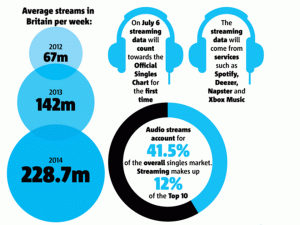
But what does this new streaming development mean for “Charts as BI” ? Well, let us look at it from the viewpoint of Big Data, and the three V’s. The Volume of UK Singles purchased sales is measured in the millions per year and so alone does not qualify for the Petabytes requirement, but the addition of streaming perhaps pushes it to the required qualifying number to be “Big Data” (over 10 billion streaming transactions have been captured in the UK alone since 1994 and currently over 200 million streams per week now take place in the UK – figures courtesy of OCC and Metro).
Velocity is quick , now updated daily on BBC’s Chart update but not real time in the UK – though the online American Billboard chart now includes a “real-time” feature (see below, Coldplay are “trending”).
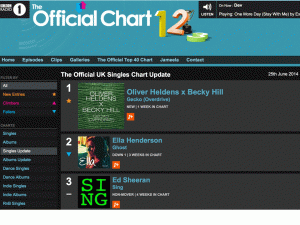 The 3rd Big Data V, for Variety, is interesting. When the Charts first started in the 1950’s, the New Musical Express used to ring around a few record shops to give an estimate of the number of records sold and so the process of determining the Top 15 (as it was then) was essentially manual and highly selective. British Market Research, then Gallup, then Millward Brown took over and they began to use EPOS (electronic point of sale) methods to get direct sales figures from shops, initially in the low thousands of shops, so it was still somewhat selective and not fully representative. Nevertheless this enabled coverage to increase to the Top 75 then 100. The Official Charts Company now publishes the charts which you see on the BBC.
The 3rd Big Data V, for Variety, is interesting. When the Charts first started in the 1950’s, the New Musical Express used to ring around a few record shops to give an estimate of the number of records sold and so the process of determining the Top 15 (as it was then) was essentially manual and highly selective. British Market Research, then Gallup, then Millward Brown took over and they began to use EPOS (electronic point of sale) methods to get direct sales figures from shops, initially in the low thousands of shops, so it was still somewhat selective and not fully representative. Nevertheless this enabled coverage to increase to the Top 75 then 100. The Official Charts Company now publishes the charts which you see on the BBC.
The next big change was in 2005 when for the first time downloaded singles, for instance from I Tunes or Amazon, were included. By 2014 we had reached the point where only 1% of singles sales were physical (i.e. CD or Vinyl) and the rest download. For albums the ratio is still near 50:50 (but physical purchases include of course on line orders from for example Amazon).
So with the addition of streaming to the mix in July 2014 we have three very different varieties of data collection which contribute to the final Chart “report”, namely EPOS physical sales from shops or on line, purchased downloads, and streaming contributions. All cleansed and conformed to enable a single report – classic BI/Big Data.
Analytics are another typical feature of big data and if we look at the processes employed by the digital music suppliers, algorithms have been built into the streaming and download services to analyse consumer habits in terms of type of music they like, to encourage similar purchases, and to create playlists. My days of compiling compilations on cassettes, and choosing vinyl on my jukebox, are long gone and it seems even compilation albums could be threatened by the possibility of consumers typing in let’s say “Saturday Night” to a streaming site and getting a ready made appropriate list of tracks.
 Graphs tend not to be used in the Charts ( the numbers speak for themselves ) but to be sure the pictures of the artists spice up the report. Recording artists and statistics lend themselves to Infographics and as ever the London Metro has provided some good ones to illustrate recent developments.
Graphs tend not to be used in the Charts ( the numbers speak for themselves ) but to be sure the pictures of the artists spice up the report. Recording artists and statistics lend themselves to Infographics and as ever the London Metro has provided some good ones to illustrate recent developments.
 The Metro argues that the addition of streaming will not make a huge difference to the results of the charts. For instance Daft Punk’s “Get Lucky“, featuring Pharrell Williams and one of my personal guitar heroes Nile Rodgers from Chic, and Pharrell’s solo track “Happy“, were amongst the highest streamed tracks but were also big No.1’s even in the traditional sales charts. Get Lucky (as seen here on YouTube ) was the first ever track to stream a million times in a single week, and was taken from the album Random Access Memories, which seems appropriate.
The Metro argues that the addition of streaming will not make a huge difference to the results of the charts. For instance Daft Punk’s “Get Lucky“, featuring Pharrell Williams and one of my personal guitar heroes Nile Rodgers from Chic, and Pharrell’s solo track “Happy“, were amongst the highest streamed tracks but were also big No.1’s even in the traditional sales charts. Get Lucky (as seen here on YouTube ) was the first ever track to stream a million times in a single week, and was taken from the album Random Access Memories, which seems appropriate.
BI reports feature KPIs and the chart is the ultimate KPI for an artist (I guess their bonus depends upon it!) Definitions are important in KPIs and I can assure you (I have read them) the definitions are very precise and extensive for what constitutes a “sale” or “stream”; for instance great detail is provided for how many different formats a track can be issued (in vinyl, 12 inch, 7 inch etc) while still counting as a single transaction. The use of the arbitary ratio of 100 streams for 1 purchase probably reflects both the actual ratio of streams to sales and the amount of money an artist gets (pence for a sale, fractions of pence for a stream) but I’m sure a case could also be made for 50 as a ratio (for example Bastilles’s Pompeii has around 25 million streams for 0.5 million UK sales). The important point as with all KPI’s is to use it as a signal that streaming is now important, and as long as this 100:1 ratio is kept the same week on week, and people are aware of it, then it is fine.
 And me? Well I embrace the same variety of music choices which now make up the charts. I use Spotify, stream it to my internet radio via my iPad , but still buy CD’s and Vinyl and download iTunes; all the time contributing Big Data to one of the greatest ever BI reports – the Charts.
And me? Well I embrace the same variety of music choices which now make up the charts. I use Spotify, stream it to my internet radio via my iPad , but still buy CD’s and Vinyl and download iTunes; all the time contributing Big Data to one of the greatest ever BI reports – the Charts.
Below: how the Billboard charts have changed, now showing real time updates, 50 years ago the magazine copy of the Beatles’ top five domination, and now the entire chart position archive is available on line.
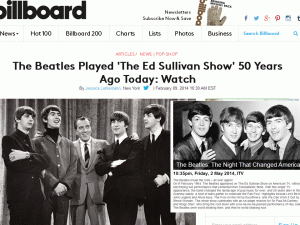 ITV very recently showed the 50th anniversary of the Beatles first appearance on the Ed Sullivan show. One of the best performances was Joe Walsh, Jeff Lynne and Dhani Harrison singing his fathers’ “Something”.
ITV very recently showed the 50th anniversary of the Beatles first appearance on the Ed Sullivan show. One of the best performances was Joe Walsh, Jeff Lynne and Dhani Harrison singing his fathers’ “Something”.
“Taxman”, released just two years later, was one of Harrison’s most famous lyrics and it made me wonder what he would write today. Tax is a subject close to many Linked In members’ hearts as they seem to be either entrepreneurs trying just to make enough money to pay tax at all, or professionals comfortably in the higher tax bracket.
“One for you, nineteen for me” indicates the 95% tax bracket for higher rate earners in those days in Britain, in 1966. Well that has certainly gone, with higher rate now being 40% to £150,000 and 45% beyond. In fact the 95% rate was approximate, an average of 83% for earned income and 98% for unearned. High enough anyway to persuade the Rolling Stones to decamp to lower tax rate France to record Exile on Main Street in 1971, Ironically, in 2014, France’s higher rate of 75% is much the greater.
Then the specifics:
“If you drive a car, I’ll tax the street
If you try to sit, I’ll tax your seat
If you get too cold I’ll tax the heat
If you take a walk, I’ll tax your feet”
Car tax is typically £145, street tax has moved through various incarnations from the Rates, to Poll Tax, to Community Charge, to Council Tax, which varies from around £800 to £2’500 per annum per house. And Stamp duty (origins: the physical stamping of documents) payable on House Purchase prices, varies from 4% to 5% in London, for instance. Value Added Tax (VAT) is 20% on, for example, furniture (unless the seat is a child’s car set) and on energy you can pay a reduced rate on energy saving materials. On shoes the rate is 20% (again with exceptions for children).
“Now my advice for those who die
Declare the pennies on your eyes”
Some say the ferryman in Greek mythology required the pennies to allow crossing of the River Styx; nowadays the tax threshold is £325,000, after which 40% is paid.
And Harrison writes, this time in the name of the taxman, “don’t ask me what I want it for”. A reasonable question, and I think these days we are much more aware of the use to which Tax is put (welfare, defence, NHS, education to name but a few).
George Harrison’s backing lyrics refer to Mr Wilson and Mr Heath, the Prime Minister and Opposition leader of the time. These days we have Mr Cameron and Mr Milliband and though there are nuances of differences, I do not think any politician would propose a return to the days of “one for me, nineteen for you” and It would be incorrect for the taxman to say “you are working for no one but me”. For instance below £10,000 per year you pay no income tax at all. Perhaps we need one of the PM’s Info-graphics to explain it.
In fact arguably George might suggest, being philanthropic, as proved by his Concert for Bangladesh, that the higher rate is now too low. Sadly we will never know his current views. But one thing is for certain, tax remains a controversial subject, certainly an important consideration in the type and amount of work you do, and the Taxman song remains an iconic rallying call, as evidenced by the song frequently being played on American radio to signal the April deadline for tax submissions. The song remains the only Harrison composition to be first track on a Beatles album, the 1966 Revolver that some would say is the greatest of all time, and the riff one of the greatest guitar pieces that George didn’t play (yes, it was Paul with a rare outing on lead).
Parisian Holiday part 2 ; My top 5 international BI heroes
Parisian holiday part 2: inspiration for Business Intelligence
Rick Anderson from A de V continues to recount finding inspiration for BI in the most unlikely places – a Parisian restaurant inspires tips on BI and a top five list of the great international BI heroes who have inspired him.
Degree of “stinkiness” in French cheese – can even this be quantified?  Staying at the marvelous Hotel Quai Voltaire on the rive gauche of the Seine opposite the Louvre – the hotels’ previous guests include Oscar Wilde and Sibelius – it is only a short walk to the Paris Latin Quarter, setting to the current production of La Boheme at the London Royal Albert Hall, and home to the Boulevard St Michel, immortalised in one of the Sixties’ best and most poignant songs, Where Do You Go To My Lovely by Peter Sarsted. While eating in the Quarter’s charming French restaurants and cafes (reports of whose death is exaggerated) there were so many Business Intelligence lessons that occurred to me (I have mentioned before, I am a sad person). My view of benchmarking is that you should compare not just your outcomes i.e. metrics but also the inputs i.e. processes. A good input tends to lead to a good output. Yes I know it’s not obvious how restaurant’s methods can inform Business Intelligence but please bear with me.
Staying at the marvelous Hotel Quai Voltaire on the rive gauche of the Seine opposite the Louvre – the hotels’ previous guests include Oscar Wilde and Sibelius – it is only a short walk to the Paris Latin Quarter, setting to the current production of La Boheme at the London Royal Albert Hall, and home to the Boulevard St Michel, immortalised in one of the Sixties’ best and most poignant songs, Where Do You Go To My Lovely by Peter Sarsted. While eating in the Quarter’s charming French restaurants and cafes (reports of whose death is exaggerated) there were so many Business Intelligence lessons that occurred to me (I have mentioned before, I am a sad person). My view of benchmarking is that you should compare not just your outcomes i.e. metrics but also the inputs i.e. processes. A good input tends to lead to a good output. Yes I know it’s not obvious how restaurant’s methods can inform Business Intelligence but please bear with me.
One of our cafes was a Thai: chopsticks were used. But I can’t use them, or so I thought. My wife Alison pointed out some instructions on the packet containing the chopsticks. They were brilliant. Finally a clear indication of where to hold your fingers and thumbs. It worked! Have you ever put out a list of tips to your bi Report users even if they seem obvious? Such as what to do if your report does not run (narrow down the population in the input screen) or how to drill down (drag and drop or double click) and so on. It’s better to communicate this too much than too little.
On to the cheese (naturally before the desert en France). And naturally four types, of increasing degrees of strength, from Emmental and Brie, up through Camembert to Roquefort. If we were in Nando’s , the degree of chilliness (in other words hotness ) would be indicated pictorially by the number of red chillies; in some curry houses the strength is indicated by the description from Korma upwards finishing at Vindaloo. In Business Intelligence a typical rating system metric might be for credit rating, where in your own company or for countries, a credit rating might be triple A. But how do you judge? It might be on the metric Days of Sales Outstanding, relating aged debt to average revenue over three months. A wonderful metric. Most processes can be measured, But are there some things better left unquantified? Well cheese strength for a start. You just know which is stronger, and if you don’t it’s fun to find out.
The top five “managers who are chefs” and top five BI heroes
Our food was great. From simple steak and pomme frittes to more exotic fish dishes, French cuisine is thriving. Le Roux is not a restaurant we could afford but it made me think, how would you create a top five “waterfall” celebrity chef’s list based not on their creative outputs but on their management inputs. Which have exhibited the best management skills? Here would be my list.
1. Jamie Oliver. Has reinvented himself many times over to keep the brand fresh. From the Naked Chef through the school meals campaign to the American tour. Along the way reinvesting much of his money in training young unemployed kids to be chefs. Putting himself on the line for what he believes in.
2. Raymond Blanc. Had the guts to establish himself in a foreign country and trained some of the best (including Blumenthal and Pierre White). And is genuinely a nice fellow (you don’t have to shout)
3. Delia Smith. Has played the long game over many decades and proves that a consistent, high quality technique and product can sell over and over again. And has reinvested her money in the love of her life, Norwich City football club (lets be ‘avin you).
4. Mary Berry. In many ways similar to Delia, with a difference. She had the guts in early life to come to Paris to train at Le Cordon Bleu (see below) developed a speciality (baking) and remained at the top of her profession for fifty years.
 5. Rick Stein. Is said to “own” Padstow (actually a couple of restaurants) and has shown the ability to manage his own business supremely before embarking on his TV and literary career. Recent tour of India searching for the prefect curry showed himself in a lovely, unassuming, culturally sensitive light.
5. Rick Stein. Is said to “own” Padstow (actually a couple of restaurants) and has shown the ability to manage his own business supremely before embarking on his TV and literary career. Recent tour of India searching for the prefect curry showed himself in a lovely, unassuming, culturally sensitive light.
The point of mentioning the above is this: with a metric, or benchmark, do not just think of the output, or the display technology, think of the process behind it, the Meta benchmark. Ask not just what a company has achieved, but why and how. For instance it’s clear that all the above love their job and have put their 10,000 hours and more into their career. And so who would my equivalent top five be in the world of Business Intelligence? Who are my BI heroes?
Well, here goes. Controversy coming. Yes I know I should start with the leaders of IBM and SAP (but who are they?) or with Steve Jobs of Apple. But I won’t.
1. Michael Saylor (MicroStrategy) . Initially a U.S. Airforce pilot, his early company survived a disaster some years ago after MicroStrategy’s share price crashed and stuck with it. Why? Because he believes in dashboards, reports, speed of response time, and was promoting Mobile and the possibilities of BI in Social Media very early. A real visionary, one assumes he has been courted by the big boys many times but up to now how has rejected their advances, I guess because he loves his company and loves business intelligence, and is happy not to diversify away from his core offering. And the reward is a consistent place in the top quartile of the Gartner magic quadrant. A true modern BI hero, who appreciates the beauty of dashboards, and his Saylor Foundation promotes free education.
2. Kaplan and Norton (Balanced Scorecard). Burst onto the scene with their definitive Harvard Review article and ever since then have been heroes of mine and are still at the top of their game. They are not especially interested in technology, rather in the framework of metrics and performance management systems, and the ability to turn strategy into action by measuring the things that matter and responding to the results. I have designed many scorecards for many companies and it still gives me a kick to collect the results, generate the KPI’s and work with managers to develop the targets and action plans.
3. Bill Gates (Microsoft). Because he was visionary, backed his hunch as a young entrepreneur, but most important for me made business intelligence available cheaply and easily for the masses – through, yes, the Excel spreadsheet. When I started working in this field, transfer of data involved downloading to a floppy disc, placing it in an envelope and posting it snail mail. Excel changed all that. Now at this stage I know that many of my BI colleagues will view this as he racy (just as Bob Dylan’s folk fans never forgave him for his first electric concert) but I would say this: I am a huge fan of “proper BI” (dashboards, data warehouses, cubes and so on) but the vast majority of BI is still done on excel and is fit for purpose. Yes there can be errors, but there can be errors in more sophisticated applications as well. There is a war waged by some of the BI community upon Excel, but it is an unnecessary and unwinnable war, not least because accountants (although they won’t admit it) still use spreadsheets all the time (and accountants still rule).
4. W. Edward Deming (Statistician). Involved in six sigma, statistical process control, and the plan-do-check-act cycle. One of the pioneers, an American who introduced Japan post-war to quality techniques, one of the first to realise that statistical techniques could be applied to not just manufacturing but also services like banking. Inspired many others in the field like Shewart and Oakland. A forerunner perhaps of the big data movement, and indeed the use of stats in sport (see above) and a reminder that Business Intelligence professionals should deeply understand the content and structure of their business metrics rather than the technology per se with which to gather and display the data, and to emphasise that BI is not an end in itself, rather just a cog in the plan-do-check-act chain. Statistical methods can help us in BI to determine what outlier points are, and what genuine break points in a trend are, and what just noise is.
5. Philip Crosby (Total Quality). Out of fashion somewhat, but with his cost of Quality and Price of Non Conformance was one of the first to bring $ quantification to good, and bad, management processes. His programme transformed a huge company I worked for in the 1980’s and certainly inspired me to switch from operations into reporting and then BI. Also an early hint of my passion, management infotainment, in the famous “Briefcase Company” in his training manuals.
 Special Mention: for Bernard Liautaud (left), cofounder of the great Business Objects in 1990, still a great application. But didn’t make my top five because the company did not remain independent, and, well, because he is impossibly young and good looking!
Special Mention: for Bernard Liautaud (left), cofounder of the great Business Objects in 1990, still a great application. But didn’t make my top five because the company did not remain independent, and, well, because he is impossibly young and good looking!
What do readers think (about my list, not about the attractions of Saylor (right) and Liautaud) ?
The doughnut as chart-type of choice
Back at the hotel, I was reading the Figaro and noticed an interesting chart showing 48% of French people felt deception (disappointment) with the EU compared to only 35% who felt espere (hope). Now that’s a surprise perhaps, but what fascinated me more (again, a sad person) was the choice of chart type to display the data: the coloured doughnut. the pie chart with the hole in the middle
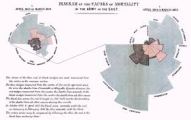 (Pie charts have come a long way since Florence Nightingale invented them to display the proportion of soldiers who died waiting for treatment as opposed to in-battle. True, and this is a classic case of a dashboard leading to actions and decisions: government heads were turned, hospitals built). The Economist also uses the doughnut, and specific styles of bar and line charts, and always in the same colour combinations. It has a house style which it sticks to. Does your company have that consistency in your PowerPoint presentations? Note in contrast by the way that the International New York Times had no graphs, dashboards, or highlighted numbers in it at all (deliberate, or did I just catch it on a bad day? ). In general though, the media increasingly embroider their articles with Infotainment style dashboard presentation; in London the Evening Standard and Metro are both excellent examples (when featuring conservative and bold financial forecasts, the Standard plots the figures against photos of hawks and doves (imagine doing g that for your Board management pack – why not?!)
(Pie charts have come a long way since Florence Nightingale invented them to display the proportion of soldiers who died waiting for treatment as opposed to in-battle. True, and this is a classic case of a dashboard leading to actions and decisions: government heads were turned, hospitals built). The Economist also uses the doughnut, and specific styles of bar and line charts, and always in the same colour combinations. It has a house style which it sticks to. Does your company have that consistency in your PowerPoint presentations? Note in contrast by the way that the International New York Times had no graphs, dashboards, or highlighted numbers in it at all (deliberate, or did I just catch it on a bad day? ). In general though, the media increasingly embroider their articles with Infotainment style dashboard presentation; in London the Evening Standard and Metro are both excellent examples (when featuring conservative and bold financial forecasts, the Standard plots the figures against photos of hawks and doves (imagine doing g that for your Board management pack – why not?!)
The Eiffel Tower and the Balanced Scorecard.
No trip to Paris is complete of course without a trip to the Eiffel tower. While standing in the inevitable queue, I mused on the four piliers at the base of the tower. First I thought, if I was designing a scorecard for a French company I would use a model of the tower to describe the four key success factors of the scorecard, but then I was reminded of my feeling that Kaplan and Norton’s four “piliers” (Learning, Internal, Finance, and Customer perspectives) are perhaps not enough. I often favour using six (for example for a manufacturer, HSE, reliability, quality, cost, project management and energy consumption) and then hanging a couple of measures on each.
 The thing about Paris is that everywhere you go you see the Eiffel tower: likewise your dashboard should be ever present throughout your company, big and brash and digitally projected, and not just paint a picture of your company but be the picture. And hopefully not obscured by cloud (See left!)
The thing about Paris is that everywhere you go you see the Eiffel tower: likewise your dashboard should be ever present throughout your company, big and brash and digitally projected, and not just paint a picture of your company but be the picture. And hopefully not obscured by cloud (See left!)
Waterloo Sunset – the in Motion Audi Dashboard.
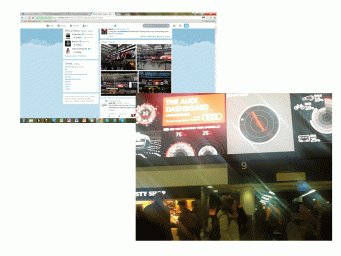 A final trip to Napoleon’s tomb then the Eurostar to St Pancras and eventually, appropriately, we met our Waterloo at the eponymous station, to be greeted by, well, an enormous dashboard, a 130 foot Audi dashboard in fact. It made use of the new In Motion screen. My favourite piece was the screen showing four shiny vinyl 45rpm singles masquerading as Audi car wheels for the advert “whatever the weather”, and of course the choice included Ice Ice Baby and Walking on Sunhshine. Management Infotainment is indeed catching on!
A final trip to Napoleon’s tomb then the Eurostar to St Pancras and eventually, appropriately, we met our Waterloo at the eponymous station, to be greeted by, well, an enormous dashboard, a 130 foot Audi dashboard in fact. It made use of the new In Motion screen. My favourite piece was the screen showing four shiny vinyl 45rpm singles masquerading as Audi car wheels for the advert “whatever the weather”, and of course the choice included Ice Ice Baby and Walking on Sunhshine. Management Infotainment is indeed catching on!
Bon Voyage
Rick Anderson
A de V
When not just red light spells danger
In the Singapore FT I noticed the headline “French Debt in is Danger Zone”. If Governments across the world whether in the USA France or America has published a debt or deficit dashboard only a few years ago and classified their debt as lets say Yellow then surely it would be Red, or Deep Purple now!. But I suspect that Governments under pressure from electorates and markets alike would like to reset the bar as to what constitutes Red. Each year the USA resets the bar as to what the maximum allowable debt is and the trillions keep on rising. So today’s yellow on a world debt or deficit dashboard could be yesterday’s red.
But this happens elsewhere. My perception perhaps wrongly was that a few years ago Global Warming would be measured by the rise in temperature, with droughts predicted. However as America freezes and the UK is swamped by floods, it is an “inconvenient truth” that Climate Change is now also measured by number of inches of rain per month, with the UK in January suffering in the classic phrase the “highest since records began” in 1710.
Re-calibrations like this are also often done in industry; plant utilization might be redefined to exclude certain factors beyond internal control such as market demand, or train punctuality might be redefined to exclude delays caused by for example the weather, or of course, the wrong kind of weather.
My advice is this. Try and keep the same definition year after year to measure progress on a constant basis. If you feel that this benchmarks you unfavorably against competitors then by all means keep an internal measure as well as an external measure. Do not fool yourself that no opportunities for improvement are possible by resetting the bar too easily.
Imagine that auditors came to see your KPI programme. Would it stand up to scrutiny or would they cry foul?
I think the policy should be to measure and then explain, rather than chanage the definition to artificially improve the result.
Red Light Spells Danger – are executive dashboards just for executives?
A headline from the Singapore straits showed a traffic light system to be employed on the local Underground, on the platforms to indicate if platforms were busy (red), reasonable (yellow) or empty (green). Red light spells danger as Billy Ocean and later the Top Gear gang sang. My friend Jonathan Ng a fellow BI traveler told me he had seen this in action that very morning and we concluded that this was an executive dashboard for the masses but speculated whether anyone would really take notice? In London, would commuters on the Drain or Jubilee line hold back if they saw red, or would it be Simply Red all the time?





